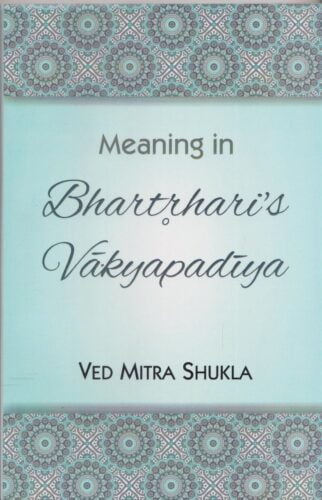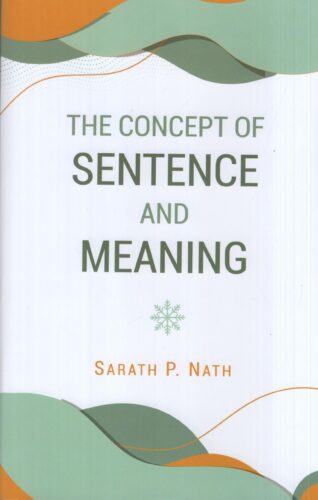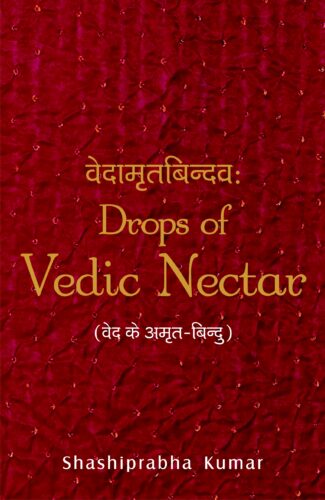Showing all 9 results

Atreyashiksha holds a unique position in the corpus of the Shiksha literature. It shows that the main aim of the text is to explain the practical aspects of the different ways of Vedic recitation, in whose connection it describes the theoretical elements of Shiksha too. The phonological rules, most of which are expressed in the Taittiriya Pratishakhya, are also illustrated in this text.
Atreyashiksha is one of the Shiksha texts of the Krishna-Yajurveda, Taittiriya school. This text has been critically edited and translated consulting two palm-leaf manuscripts which are currently the only discovered manuscripts of this text in public libraries. Shiksha texts deal with phonetics and phonology of the Vedas and the method of proper pronunciation and recitation. The Atreyashiksha is well-structured in terms of arranging its topics of discussion.
When compared to the other Shikshas of the Taittiriya school, the Atreyashiksha, in keeping its focus on the discussion on the different methods of Vedic recitation, namely, word-reading (padapatha), sequential reading (kramapatha), tangled reading (jatapatha) and the five varieties of the reading of the phonic sequences (varnakramas), holds a unique position in the corpus of the Shiksha literature. A close reading of the text shows that the main aim of the text is to explain the practical aspects of the different ways of Vedic recitation, in whose connection it describes the theoretical elements of Shiksha too.
The book, therefore, serves as a practical guidebook to Vedic reciters who recite the above-mentioned readings of the Taittiriya Krishna-Yajurveda along with the continuous reading. While describing the methods of recitation, the Atreyashiksha gives enough emphasis on the theoretical nuances. The phonological rules, most of which are expressed in the Taittiriya Pratishakhya, are also illustrated in this text. This book consists of a detailed introduction, the critically edited text in Devanagari script, its Roman transliteration and an authentic English translation.
Renowned Vedic scholar, Pandit Madhusudan Ojha has presented in this volume a rich and ancient history of our world and civilization.
Jagadguruvaibhavam, the final part of the trilogy authored by Ojhaji on various facets of Creation, is as much an insightful work on the Vedic knowledge contained in the Vedas and Puranas as also an exceptional example of his profound knowledge and wisdom. Indravijayah (Bharatavarsha: The India Narrative in English) and Devasurkhyati are the first two volumes on the subject.
The Brahma’s Universe: The Chronicle of Creation is the English translation of Jagadguruvaibhavam prepared by a board of editors at Shri Shankar Shikshayatan headed by well-known Indologist, Prof. Kapil Kapoor.
Brahma is the central character of this book and through his forms, age and abode, Ojhaji has outlined the story of our universe’s evolution. It was Brahma who perceived that, in this world, the source of energy is the surya or sun. All spiritual, metaphysical and supraphysical energies exist in the surya. The vital energy (prana), which gives life to all beings too is produced from the sun. Brahma recorded all these in granthas (volumes) that came to be known as the Vedas.
Written in verse form, the volume offers a unique rendering of the creation of atma, veda, praja and dharma. Ojhaji presents a remarkable insight into the ancient knowledge on rivers, mountains, eras and communities like Sadhyas and Manijas.
Brahma’s Universe is more than a companion book of Bharatavarsha: The India Narrative. It expands the magnificent narrative of Creation, offers broader meaning to Vedic terms and illuminates the profound wisdom contained in the Vedas.
Philosophy in this set of two volumes is a cognitive activity par excellence. Cognition is that the language expresses and it reveals intelligible objects/beings of language and the meaning to which our philosophical reflections, investigations, analysis and interpretation are not only based on but are confined to. The work is fit for satisfying the intellectual hunger of those who are sick of reading the same metaphysical, ontological, theological and epistemological descriptions in different books of history of philosophy, Indian and Western, to those searching a philosophy free from our captive thinking and also an innovative vision to meet out the new challenges in philosophy. Concentrating on cognition as it flashes by language the book analyses, discusses, interprets and critically argues most of the philosophical issues and their responses by Indian and Western philosophical traditions well conclusively.
Unlike linguistic and analytic philosophies, the book is a philosophy of language. Unlike meaning-centric philosophies popular in the East and West, the language-centric approach of the book is based on the expressive nature of language. Based on cognition as it flashes, on active theory of knowledge and action-oriented view of language and its meaning, it reflects on problems, doubts, paradoxes and queries for clarity and resolve, and on that basis, utility and future of philosophy as well.
Against philosophy as subjective and objective thinking, it is a cognitive reflection par excellence. These volumes cover the courses of philosophy prescribed in the universities and colleges useful for scholars and students and those who want a fresh perception to come up with the new challenges in philosophy.

This volume delves upon the Vakyapadiya of Bhartrhari, written in fifth century ce, as a contnuity of the theory and praxis of Panini and Patanjali on Sanskrit grammar and Indian language philosophy. It makes an attempt to explore and analyse some issues such as meaning of language, theory of sphota, and conditions and context of meaning.
The study of grammar and linguistic philosophy had its origin in the Vedic period, at least in the second millennium bce. The Vakyapadiya of Bhartrhari, an authoritative Sanskrit text written in the fifth century ce, contains reflections on the subject matter of language and grammar, thus the philosophy of language. Interpretation of communication is one of the principal objectives of Bhrtrhari’s philosophy of language. His goal is to interpret the communication of all living things, be it a man or an animal, or a yogi or a baby.
Bhartrhari represents a rich tradition of Indian philosophy of language that he inherited from Panini and Patanjali. The West, for all practical purposes, lagged behind in grammar, literary theories, philosophy of language and with the problems of meaning, even at the dawn of the twentieth century, when the Indian Grammarians made penetrating studies on the same even before the common era.
This volume delves upon “meaning” discussed in the Vakyapadiya as a continuity of the great Indian literary tradition, philosophy and grammar. In the process, it explores and analyses some issues such as meaning in Indian philosophy of language, theory of sphota, and conditions and context of meaning.
The study of grammar and linguistic philosophy had its origin in the Vedic period, at least in the second millennium BCE. The Vakyapadiya of Bhartrhari, an authoritative Sanskrit text written in the fifth century CE, contains reflections on the subject matter of language and grammar, thus the philosophy of language. Interpretation of communication is one of the principal objectives of Bhrtrhari’s philosophy of language. His goal is to interpret the communication of all living things, be it a man or an animal, or a yogi or a baby. Bhartrhari represents a rich tradition of Indian philosophy of language that he inherited from Panini and Patatijali. The West, for all practical purposes, lagged behind in grammar, literary theories, philosophy of language and with the problems of meaning, even at the dawn of the twentieth century, when the Indian Grammarians made penetrating studies on the same even before the common era.
भारतवर्षीय दर्शन परम्परा में अनेक सम्प्रदाय, पद्धतियां, चिन्तन–मार्ग और साधना के आयाम हैं। वे सभी पद्धतियाँ मुख्यत: तीन ग्रन्थाें पर आधारित हैं। जिनमें कुमारिल भट्ट का श्लाेकवार्त्तिक, धर्मकीर्ति का प्रमाणवार्त्तिक, तथा गङ्गेश उपाध्याय का तत्त्वचिन्तामणि हैं। वे तीन ग्रन्थ आज तक की भारतीय दर्शन परम्परा के प्रतिनिधि ग्रन्थ हैं और तीन मार्गाें के रूप में स्थापित हैं। हम कुछ भी चिन्तन, लेखन या विचार करते हैं ताे वे इन तीनाें में से किसी एक मार्ग में स्वतः ही चले आते हैं।
धर्मकीर्ति का यह प्रमाणवार्त्तिक ग्रन्थ अत्यन्त कठिन हाेने से इस ग्रन्थ का अब तक किसी भी भाषा में पूर्ण रूप से अनुवाद नहीं हाे पाया है। इसके कुछ श्लाेक अंग्रेज़ी में अनुदित हैं ताे कुछ हिन्दीए फ्रेंचए जर्मन और नेपाली में भी अनुदित हुए हैं। किन्तु अब तक पूर्ण ग्रन्थ का और इसकी किसी भी टीका का पूर्ण अनुवाद न हाेना इसकी भाषा का कठिन हाेना, विचाराें का गूढ़ हाेना तथा अत्यन्त दुरुह प्रकरणाें का हाेना ही कारण रहा है। कुछ विदेशी विद्वान् इसका अंग्रेज़ी में अनुवाद करने के लिए भी लगे हुए हैं किन्तु बीसाें वर्षाें के बाद भी वे इसे पूरा नहीं कर सके हैं। अतः यह हिन्दी अनुवाद अपने आप में प्रथम पूर्ण अनुवाद और सम्पादन है।
प्रस्तुत ग्रन्थ में पाँच प्रकरण हैं – 1. प्रमाण सिद्धि परिच्छेद, मनाेरथनन्दी के साथय; 2. प्रत्यक्ष परिच्छेद, मनाेरथनन्दी के साथ; 3. स्वार्थानुमान परिच्छेद, स्वाेपज्ञवृत्ति सहित (जाे कि धर्मकीर्ति की अपनी ही वृत्ति है); 4. स्वार्थानुमान परिच्छेद, मनाेरथनन्दी के साथ; और 5. परार्थानुमान परिच्छेद, मनाेरथनन्दी के साथ।
इस ग्रन्थ में प्रथम बार समग्र प्रमाणवार्त्तिक का उपस्थापन किया गया है। इस में स्वयं धर्मकीर्ति की स्वाेपज्ञवृत्ति स्वार्थानुमान परिच्छेद में वर्णित है जिसका अनुवाद सहित उपस्थापन पाँचवें परिच्छेद के रूप में रखा गया है।
The experiences and knowledge from our past are recorded in manuscripts which have been handed down to us over several thousand years. The Government of India, through the Department of Culture, took note of the importance of this vast tangible heritage and, in order to preserve and conserve as well as to make access to this wealth easy, established the National Mission for Manuscripts (NMM). In order to disseminate the knowledge content of manuscripts, the Mission has taken up several programmes such as lectures, seminars, and workshops. The Mission publishes the proceedings of the above-said programmes under the following series: “Samrakshika” (on conservation), “Tattvabodha” (comprising lectures based on manuscripts delivered by eminent scholars), Samikshika” (research-oriented papers presented in the seminars), and “Kritibodha” (transcribed and edited texts prepared at advanced level manuscriptology workshops conducted by NMM).
NMM has taken up a project for publishing rare and unpublished manuscripts in three forms: (a) facsimile, (b) critical edition with annotation, and (c) critical edition with translation. This series has been named as “Prakashika”.
This critically edited volume of the Shivajnanabodhabhashyam is a commentary by Shivagrayogin, an acclaimed authority on Shaiva Siddhanta, on the Shivajnanabodham of Meykandadeva, another great exponent of Shaivaism. It is the most authentic, canonical and methodical work on Shaiva Siddhanta. It stands as a mark of classical scholasticism in the Indian philosophical system. It is 39 in the Prakashika Series.

The book systematically presents the philosophical dimensions of grammatical units. The author has attempted to present the philosophy of language in a Bhart¦harian perspective. To substantiate his views, syntactic and semantic thoughts in India are elaborately discussed.
Definition and sense of the “meaning” were a great concern for the Indian thinkers. In order to finalize this, they have examined all the components of a communicative unit such as syllables, words, sentences and intentions of the speakers. After this examination, different philosophers, specifically, Mimamsakas, Naiyayikas and Shabdikas have arrived at the conclusion that sentence is an essential component to convey the sense of meaning to the listener. The theory of akhandavakya is based on the indivisible sphota theory and the sentence-meaning is experienced by the concept of pratibha. The division of sentence as per the priority of words occurred on the basis of mutual expectancy by which the intended meaning may be assumed by the listener.
The Vakyapadiya of Bhartrihari (sixth century) is a text which elaborately explains the notions on sentence. The book systematically presents the philosophical dimensions of grammatical units. The author has attempted to present the philosophy of language in a Bhartriharian perspective. To substantiate his views, syntactic and semantic thoughts in India are elaborately discussed.
Though the significance of the work can only be understood by those scholars who are well versed in Helaraja and Punyaraja, it will, undoubtedly, remain an asset to the field of grammatical deliberations.

Vedamritabindavah (Drops of Vedic Nectar) is a modest tribute to those who are genuinely interested in Vedas universal message. It is a collection of select Vedic statements with Hindi and English translations intending to communicate the Vedic wisdom to the young people of modern age. This book, with fairly accurate translations from Vedic Sanskrit, aims to acquaint the modern readers with their most ancient, richest literary heritage so that they can comprehend its worth and bring value to their life.
In spite of numerous translations available, this volume has some novelty in its content and freshness in its presentation, and stands witness to the fact that in representing Vedas, there still exist infinite possibilities.
Vedamritabindavah (Drops of Vedic Nectar) is a modest tribute to those who are genuinely interested in Vedas universal message. It is a collection of select Vedic statements with Hindi and English translations intending to communicate the Vedic wisdom to the young people of modern age. This book, with fairly accurate translations from Vedic Sanskrit, aims to acquaint the modern readers with their most ancient, richest literary heritage so that they can comprehend its worth and bring value to their life.
In spite of numerous translations available, this volume has some novelty in its content and freshness in its presentation, and stands witness to the fact that in representing Vedas, there still exist infinite possibilities.
| There are no products |